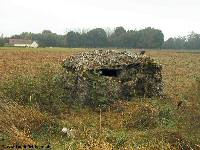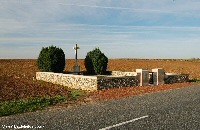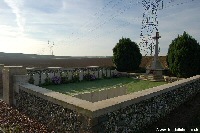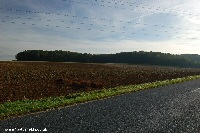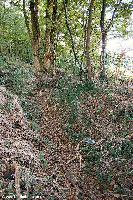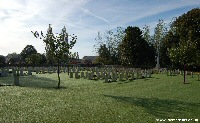Gommecourt & Area
The World War One Battlefields site is undergoing a major update, with pages being converted to a new, user-friendly mobile format. The updated pages can be found at Updated World War One Battlefields. Some pages such as this one remain in the original format pending update.
Gommecourt, located about eight miles north of Albert, was the site of a 'supplementary' operation on the 1st of July, 1916, with two aims - to draw some German reserves from the main Somme offensive further south and also to try and eliminate a German salient here in the lines, which was centred on Gommecourt Wood. The attack was mounted by VII Corps, with the 46th Division attacking to the north of the salient, and the 56th to the south. The intention was for troops from the two Divisions to meet and thus 'pinch out' the salient here. The advance of the 56th Division went quite well initially, with the enemy's first two lines taken, but there was more resistance from the third line.
However, the 46th (North Midland) Division did not fare so well. The wire in front of the German trenches had not been cut by the barrage, and although a few men of the 1/6 South Staffords and 1/6 North Staffords did get into the enemy's front-line trenches, they and the other attackers here (battalions of the Sherwood Foresters) had little success and were driven back with significant losses. To the south, men from the 56th (London) Division eventually withdrew in the evening, and the net gain that day here was effectively zero.
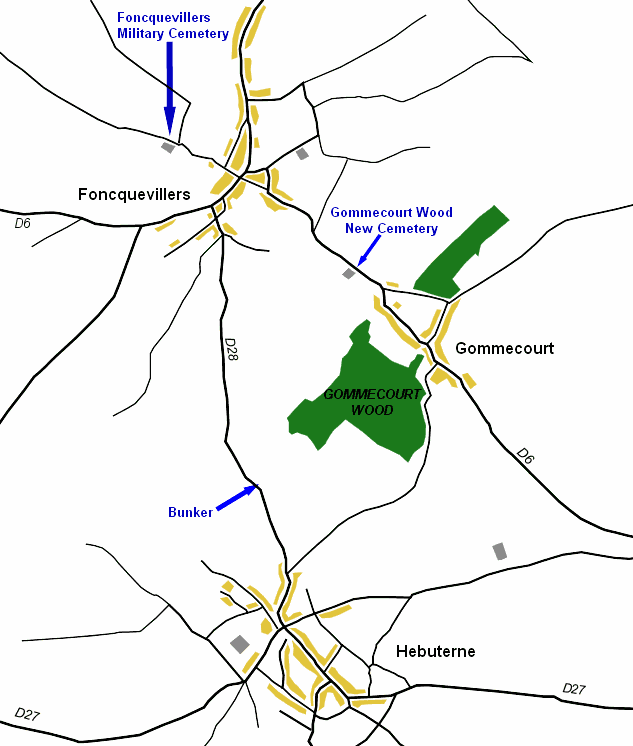
Map of Gommecourt area
The Germans vacated their lines here when they withdrew in February 1917, and did not reach quite this far when they advanced again in Spring 1918.
Foncquevillers
Foncquevillers is a village which was just behind the British front lines in the 1916 battles. Foncquevillers Military Cemetery is to the north-west of the village, and was originally begun by the French (when they held this part of the line). When the British took over this sector, they continued to use it, with many burials dating from July 1916, the early Somme offensives.
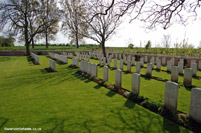
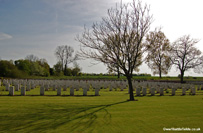
Foncquevillers Military Cemetery
The cemetery is located on the site of a cemetery which stood here before the war, and is bordered by a low stone wall all around with a wooden gate at the entrance. In Plot 1, Row L are headstones marking what is in effect a mass grave of men who died on the 1st of July, 1916. Many of the headstones have three names inscribed.
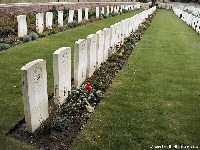
A mass grave: Foncquevillers Military Cemetery
At the front left are three special memorials to men known to be buried in this cemetery. The cemetery was used until March 1917, when the front lines moved well away from this location, but a year later, the great Spring Offensive by the Germans in March 1918 meant that the cemetery began to be used again. There are now 652 First World War graves here (including four German graves); only 74 of these were brought into the cemetery after the Armistice; men who fell in both the 1916 and 1918 battles near here. The relatively small number of later graves, plus the location behind the lines, explains why most of the burials (593) are identified.
The original French graves were moved from here to the large French Cemetery at la Targette (which can be seen on the Vimy Ridge surrounding area page). The empty area at the front left, near the Stone of Remembrance is where these French graves were located.
Many Chinese provided labour during the First World War, and there are two Chinese Labour Corps men buried here. One of these headstones is shown below (this man died after the Armistice).
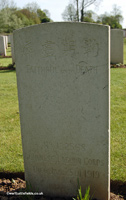
Chinese headstone at Foncquevillers Military Cemetery
As well as the Great War burials, there are also five graves of bomber crew from the Second World War, but only three headstones (two names on each of two headstones and a single name on the third).
Gommecourt
On the road leading between Foncquevillers and Gommecourt is Gommecourt Wood New Cemetery. This is on the right hand side of the road, and is raised up above the level of the road.
This is not a wartime cemetery; it was constructed after the Armistice by the recovery of bodies from the battlefields, plus the concentration of graves from several smaller cemeteries. These included at least five of eight small original war time "Gommecourt Wood" Cemeteries, plus a number of others from nearby.
This process was necessary, as it was far more realistic to maintain fewer, larger plots of land as permanent cemeteries than the many more smaller battlefield cemeteries and isolated burial sites that existed at the end of the war. After the Armistice, the 'Directorate of Graves Registration & Enquiries', a military organisation, had the responsibility to complete the work of securing the sites of cemeteries or isolated graves and recording their locations. These would have had wooden crosses as grave markers, and often barbed-wire fences surrounding them. Following this, the Imperial War Graves Commission had the responsibility of transforming the cemeteries which were to remain into permanent ones, with headstones rather than crosses, plus suitable memorials located in each cemetery (which became the familiar Cross of Sacrifice and Stone of Remembrance).
Agreement between Governments was that, to be preserved permanently a cemetery should normally have more than 50 graves, and so smaller cemeteries and isolated graves should be concentrated into new cemeteries, or extensions of existing ones.
This was not a fixed rule; in fact several of the cemeteries concentrated to Gommecourt Wood New Cemetery had more than 50 graves themselves, and there are still a number of cemeteries with less than that number to be seen today.
Gommecourt Wood New Cemetery is located in an interesting spot: it is in the midlle of what was No Mans Land in July 1916, with the British front lines just to its right and the German lines to the left. The picture below shows a view from the back left of the towards No Mans Land and the site of the Kaisers Oak. The 46th (North Midland) Division attacked here in the diversionary battle to the north of the main Somme action on July the 1st, 1916.
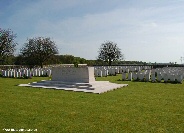
View from Gommecourt Wood New Cemetery towards No Mans Land
John Hardwick from Derby, of the 1/5th Sherwood Foresters, is one of those buried here who died on the 1st of July. He was one of three brothers who all died during the war. Many who died near here were from the 46th (North Midland) Division, and there is a plaque located in the right hand wall of the cemetery inside the entrance, commemorating the men of the 46th Division which is shown below.
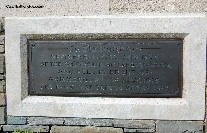
46th Division memorial plaque at Gommecourt Wood New Cemetery
Below is shown a trench map of this area dating from October 1916 - the front lines then were as they were in July. The German front lines in red project out in a salient in Gommecourt Park, and the location of the cemetery is on the left hand side of the road which crosses No Mans Land towards the top of this scan.
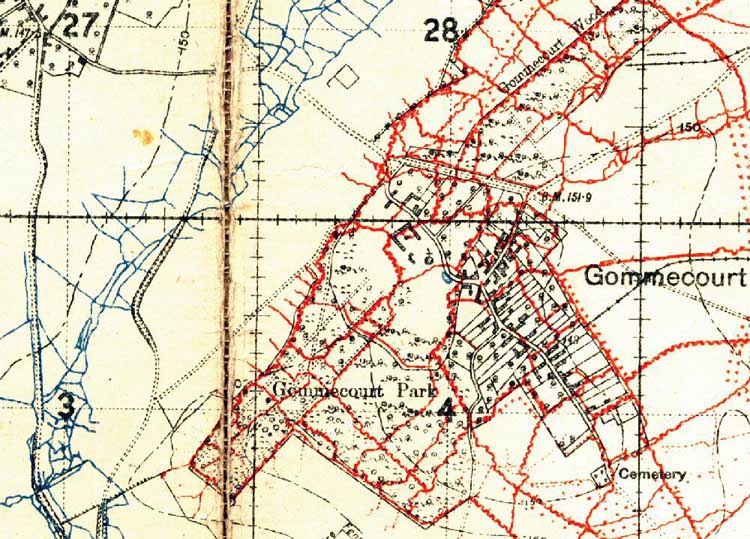
Trench Map of Gommecourt front lines
On the road between Hebuterne and Foncquevillers, as you leave the former, and just before a crucifix, is a pillbox, located in a field to the right. This dates not from the 1916 battles, but from 1918. Inside the pillbox it is very small, with a square aperture in the floor, perhaps where the observer or machine-gunner would stand to look out of the slits at the front. Two metal round pipes approximately the size of drainpipes exit at an upwards angle at the rear, on either side of doorway.
In front of pillbox in the field when I visited was the nosecone from a large shell. Unfortunately, the weather at the time was very poor, and so the picture below is not therefore of the best quality!
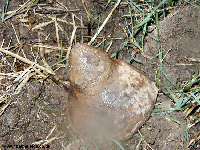
Nosecone of a shell seen near Gommecourt
On the D6 between Gommecourt and Puisieux is Gommecourt British Cemetery No. 2. Steps lead up from the road to entrance pillars, and then a broad grass track leads on to the cemetery itself which is set some way back from the road.
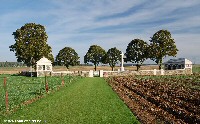
Gommecourt British Cemetery No. 2
Today this is a large cemetery with over 1,300 burials, around half of which are unidentified. The original graves in the cemetery date from the 1st of July 1916; 101 graves mainly of men from the 56th (London) Division which attacked here that day. These original four rows of graves now form Plot 1 right at the heart of the cemetery. When this cemetery was made in 1917, other cemeteries known as Gommecourt British Cemeteries numbers 1, 3 and 4 were also made nearby. This was after the Germans had withdrawn to the Hindenberg line, allowing the British to recover bodies which in many cases had lain in No Mans Land since the start of the Somme battles more than six months earlier. No. 1 and No. 4 Cemeteries were located very near to this one, whilst No. 3 was south-west of the village itself.
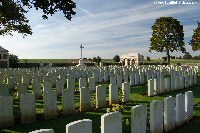
Gommecourt British Cemetery No. 2
The graves from the other three cemeteries were moved here into No. 2 after the Armistice, as were graves from other cemeteries too, and the later plots were built up around the central original plot in a manner which forms a very attractive layout to the cemetery. The superb flowers attract many butterflies, and as you walk around the cemetery some of the headstones are set very close together, some with two or three names inscribed, and the same date over and over again: the 1st of July 1916. There are special memorials to men known or believed to be among those buried here in three groups on the right hand side of the cemetery.
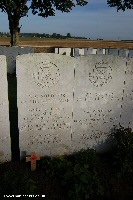
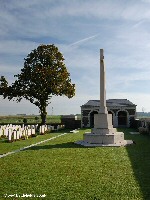
Headstones for two soldiers and the Cross of Sacrifice at Gommecourt British Cemetery No. 2
Rossignol Wood and Area
There are two small cemeteries on the left side of the D6 road between Pusieux and Gommecourt. Travelling from Pusieux, the first reached is Owl Trench Cemetery. Early on a cool and crisp October day when I took these pictures the wires on the pylons which run overhead crackled in the slight mist, otherwise all was still. Rossignol Wood can be seen opposite the cemetery, the name of which comes from a German trench here which was taken by New Zealand troops in July 1918, although the burials date from earlier. Within it, on the left hand side is a row of headstones, most with two or three names on: mainly men of the 16th West Yorkshires who died on the 27th of February 1917. These graves make up row A, and the records on the CWGC website for these men simply state 'Row A' as the burial location, without a grave number, as this is a mass grave with the exact location of individual graves unknown.
Forty-six men are buried in the mass grave in row A: on the right hand side in row B are the graves of seven unknown soldiers although their units are known: six men of the Kings Own Light Infantry (five soldiers and one Corporal) and one unknown West Yorkshire officer. This is a tiny but beautiful and peaceful cemetery.
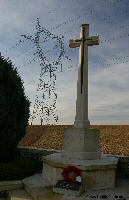
Cross of Sacrifice and power lines at Owl Trench Cemetery
A little further along the road towards Gommecourt, and again on the left side is Rossignol Wood Cemetery. This is an interesting little cemetery, as there are actually more German graves here than British ones. There are 70 German and 41 British and Commonwealth graves here. The British burials in the cemetery were begun in March 1917, by the 46th Division burial officer, with almost all these early burials being men of the North and South Staffordshires (the 1st/5th battalion in each case), killed in March 1917, many on the 14th of March. There are also a smaller number of New Zealand graves dating from August 1918.
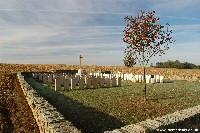
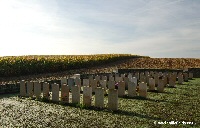
Rossignol Wood Cemetery: German graves outnumber British
After the Armistice, the German graves were made when bodies were recoverd from the battlefields just to the south and south-west of the cemetery. Of the 70 German graves, only 28 are identified. The Middlebrooks in their Somme Battlefields speculate that the German graves remain here because this cemetery lies just outside the Somme Depatment.
There is a good view from here of Rossignol Wood. The wood was taken by the Germans in their spring advance towards the end of March 1918 and was retaken around four months later.
.Continuing north-west on the D6 road, there is a cross-roads shortly after the cemetery. The left turn leads towards Hebuterne, and the small road to the right leads past the north-west edge of Rossignol Wood. Entering the edge of this wood, the outlines of trenches are immediately clear to see.
A little way in when I took these pictures there was a wreath attached to a tree commemorating Reverend T B Hardy, VC. Theodore Bayley Hardy was a man who as well as the Victoria Cross was also awarded the Distinguished Service Order and the Military Cross - and this was a man who was a non-combatant. His Victoria Cross was awarded when he was attached to the 8th Lincolns in 1918. On three days in April of that year he was involved in attending to wounded men whilst under heavy fire, without regard to his own safety. The earlier actions took place near Bucquoy, but the later ones were east of Gommecourt. There are several specific instances recorded in his citation: he dug several men out who had been buried by a shell, brought in a wounded officer from 400 yards beyond the front line and with a sergeant brought in a wounded man from within 10 yards of a German pillbox.
His VC was awarded to him by the King, but he then returned to the front, was wounded and subsequently died less than a month before the end of the war. He is buried at St. Sever Cemetery Extension near Rouen. It is almost impossible to contemplate the bravery of a man who was in his fifties and still risked his own life time and time again, not armed in an offennsive operation, but simply to try and help, rescue and alleviate the suffering of others, without a weapon and with so little thought for his own safety.
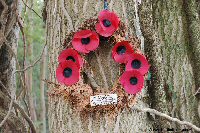
Wreath commemorating VC winner Rev Hardy in Rossignol Wood
Continuing a little further into the wood following the trench line, there are the remains of a pillbox to be seen. It is some experience to be walking in these German trenches, and to look out from the edge of Rossignol wood towards where the British lines would have been. There are commanding views over the slope leading up to the wood, and the advantage of this higher ground is immediately apparent. A trench map from February 1917 shows what may well be the trenchline which can be seen today running along the south-west edge of Rossignol Wood, which then had barbed wire entanglements located in front of it.
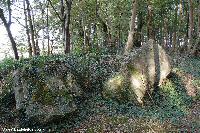
Remains of a bunker in Rossignol Wood
Returning back down the hill towards the D6, a hard-standing area at the cross-roads is one of many points where the 'iron harvest' of the Somme can sometimes be seen awaiting collection and disposal.
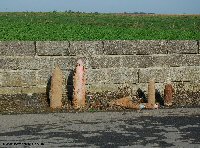
'Iron harvest' near Rossignol Wood
Hebuterne
Not far from the village of Hebuterne and set beside a farm is Hebuterne Military Cemetery. This is reached up steps through gates and then along a broad hedge-lined grass track. The graves are set with very irregular spacing between them.
The cemetery was used at various stages through the war. It was started in August 1915 by the 48th (South Midland) Division, and used by them and various other units including the 56th (London) Division until early 1917. It was used again during 1918, and is now in tgerms of burials exactly as it was at the end of the war, complete with the irregular layout that comes from it being a wartime cemetery.
There are just over 760 buried here, with most of them (712) being identified burials, reflecting that the cemetery was behind the lines and used often by Field Ambulances so the names of those who died were usually known. This is in contracst to cemeteries made by recovery of bodies from the battlefields months or even years later, where the identification of remains was much harder and so there are a higher proportion of unknown burials.
There are special memorials to 17 men who are known or believed to be buried here located behind the Cross of Sacrifice. One (that to Private H Oliver of the 1/8 Middlesex) reads 'Buried elsewhere in this cemetery'. A number of New Zealand graves are also located near the Great Cross. There were originally two American soldiers buried here, but their bodies were removed and relocated. The roses growing around the graves make a stunning display.
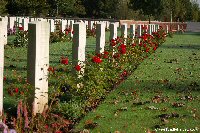
Roses at Hebuterne Military Cemetery
Plot 4 Row M contains graves from the 1st of July 1916, and the headstones have two or three names on. Many are London men, including some from the 13th Battalion, also known as the Kensingtons. They fought near Gommecourt that day, on the south edge of this 'subsiduary' action. Their role was to support the London Scottish by digging a trench across No Mans Land facing south to form a defensive flank. The officer in charge was Major Cedric Dickens (the grandson of Charle Dickens), who was killed on the 9th of September 1916. There is a memorial cross near to where he died, not far from Guillemont.
The Germans shelled the trenches where the Kensingtons were on the morning of July the 1st, as they waited for news of progress (they were not to start digging until the London Scottish had captured their objective). Their experience shows it was not just the battalions who made the initial assualt across No Mans Land at 7.30 a.m. who suffered. Few of the Kensingtons ever got out of their trenches. They could not dig the trench across No Mans Land, as the reports were not favourable, and they were shelled in their trenches as they waited for news. In the afternoon, Cedric Dickens sent reports that just after 1 p.m. the trench was 'practically untenable, full of dead and wounded. Very few men indeed left' and an hour later 'Trenches unrecognisable. Quite impossible to hold.......I am the only officer left. Please send instructions'. The Kensingtons lost 16 officers and 300 men that day, well over half their fighting strength. Some of those who died have no known grave, but others are buried here, including Second Lieutenant Mager, Private Norman Blows aged 21 from Twickenham and Lance-Corporal Sidney Price aged 23 from Chiswick.
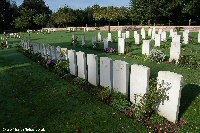
1st of July 1916 burials (many Londoners) at Hebuterne Military Cemetery
Sources & Acknowledgements
Sgt. O F Bailey & Sgt. H M Hollier: 'The Kensingtons' 13th London Regiment
Commonwealths War Graves Commission website
Gerald Gliddon: Somme 1916
Major & Mrs. Holt: Battlefield Guide to the Somme
Chris McCarthy: The Somme - the day by day account
Martin & Mary Middlebrook: Somme Battlefields
Paul Reed: Walking the Somme
The Times online archive


